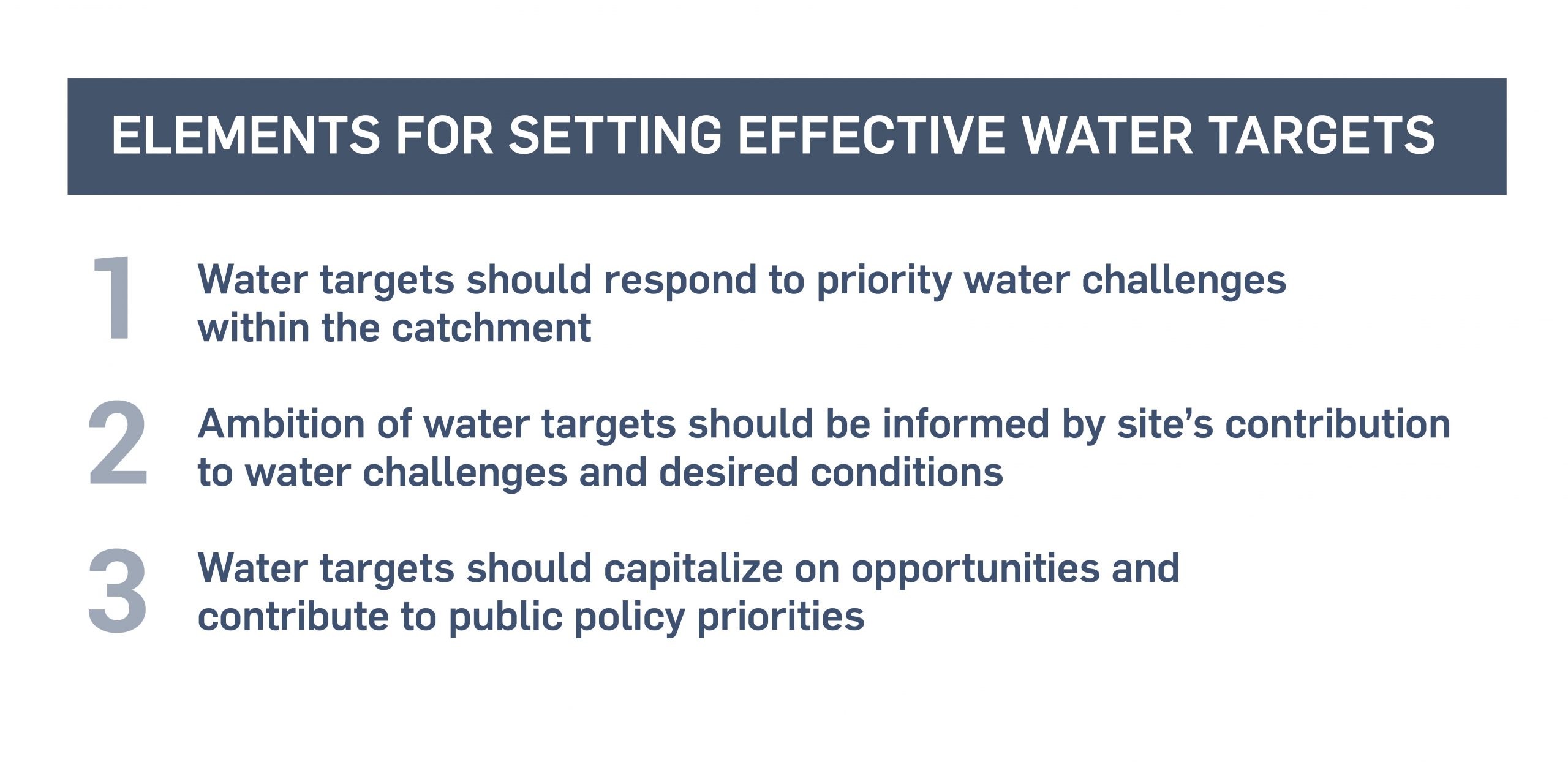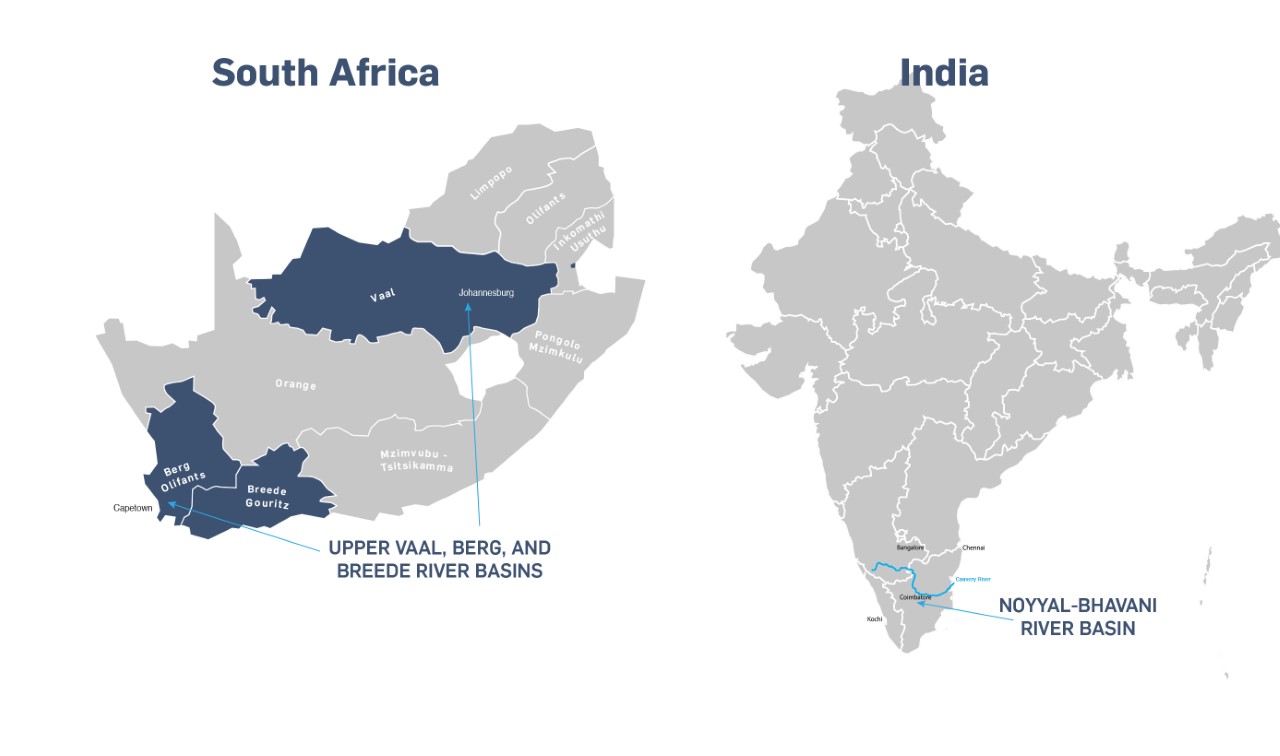By Sonali Abraham
Setting site water targets is a business imperative to reduce water risk and improve water security. Every water catchment has a unique set of water challenges. To effectively address water-related risks at the site level, companies need to take into consideration the local context.
The CEO Water Mandate, together with several partners, published a guide in August 2019 to help companies set effective site water targets that are informed by local context. The guide includes a framework that lays out three key elements for setting effective site water targets:

In parallel to creating this guidance, we piloted a series of case studies testing this framework across the globe with CEO Water Mandate Action Platform members. The pilots were held in the Santa Ana Watershed (USA), the Noyyal-Bhavani River Basin (India), and the Berg, Breede, and Vaal (South Africa) Catchments.
We recently released case studies of India and South Africa. Comparing and contrasting these two case studies elucidates the successes and challenges of implementing this guidance and can provide useful insights for companies interested in setting site water targets informed by catchment context.
Setting the Context
In both India and South Africa, the pilot studies were conducted in regions with significant water stress due to both water scarcity and poor water quality, partly driven by industrial dependence on water resources. In South Africa, the pilot study was carried out in two catchments: the Upper Vaal Catchment, which is critical for supplying water to South Africa’s economic hub, the Gauteng city-region; and the Berg and Breede Catchments, which supply the City of Cape Town with water. In Gauteng, Sasol Limited and Unilever PLC were the participating companies, while in Cape Town, Woolworths Holdings Limited and Hilton Worldwide Holdings Inc. were the companies involved.
In India, the pilot was focused on the Noyyal and the Bhavani sub-basins of the Cauvery, a region well-known as a global textile export hub that is responsible for 90 percent of knitwear exports from India. This clustered pilot was carried out in coordination with the apparel companies Levi Strauss & Co, Gap Inc., and PVH Corp., which have facilities and operations in the watershed.
Lessons Learned from India and South Africa
Lesson #1: Understand your region thoroughly
Every region is unique, not only in its water-related challenges but also its political structures, cultural customs, and historical context. If you are not based in the region, local partners can provide on-the-ground perspective and guidance. Understanding the region’s local policies and talking to people in the region will make the process more effective.
Lesson #2: Data is king
Good quality local data is essential to assess a catchment and create actionable targets. The lack of good data need not deter action, but instead can incentivize future data collection as a possible target. Alternatively, the lack of good data can mean that an alternative process, like robust stakeholder engagement, may be required to augment your understanding. Understanding these limitations will help you prepare better for the process ahead.
Lesson #3: Most water challenges are interconnected
Water challenges are often connected. For example, supply issues can manifest in the form of polluted bodies of water, which can lead to ecosystem and habitat concerns. It is important to recognize and understand these linkages in order to develop a thorough understanding of the water challenge. Distinguishing the root cause of water challenges will help identify targets that mitigate the source and not the symptom.
Distinguishing the root cause of water challenges will help identify targets that mitigate the source and not the symptom.
Lesson #4: Climate change and governance are common threads
Climate change and governance structures are overarching issues that touch every water challenge. The lack of a cohesive water governance system affects both the extent of all water challenges and the ability to analyze them. Similarly, climate change in the form of rising temperatures and changes in precipitation can affect water availability, water demand, and infrastructure. Therefore, while these two issues may not be captured in priority challenges, it is important to recognize that they will impact all challenges.
Lesson #5: Targets come in many shapes and forms
Site targets can be specific or process-related, quantitative or qualitative. While quantitative, measurable targets are the ideal, other kinds of targets can still yield meaningful action. Where there is a lack of quantitative guidance on the desired conditions of the catchment, it is better for a company to set qualitative targets than no targets at all. Additionally, companies have different administrative structures and strategies, and priorities may vary across different levels of the company. Targets that mitigate shared water risks for stakeholders across the catchment and take company strategies into account are likely to be more far-reaching and effective.
While quantitative, measurable targets are the ideal, other kinds of targets can still yield meaningful action.
Lesson #6: Collective action saves resources and creates scaled impact
Setting site water targets is resource-intensive. Working with other sites to collect data on local water challenges and opportunities will reduce the resource burden on each company. Further, implementing the targets collectively creates scaled impact, since multiple users will have a greater overall water footprint within the catchment.
Interested in learning more?
For more information on these case studies and the overall guidance, please refer to Setting Site Water Targets.
To dive deeper into these case studies and ask any and all questions, attend our webinar on August 18, 2020! Register or click here for more information.
Sonali Abraham is a Research Associate at the Pacific Institute, which implements the CEO Water Mandate in partnership with the UN Global Compact. The CEO Water Mandate mobilizes business leaders to advance water stewardship, sanitation, and the UN Sustainable Development Goals.



